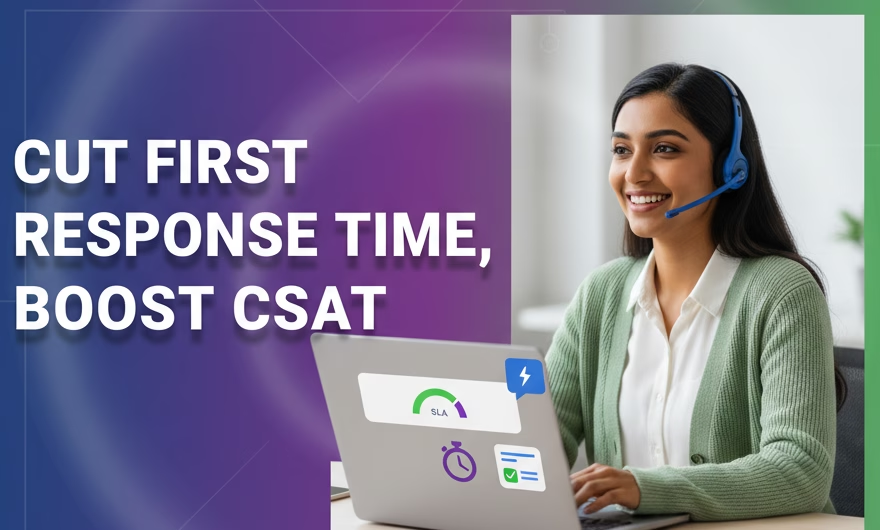First Response Time (FRT) is the time it takes for a customer to receive the first meaningful reply from a customer service agent after submitting a query. It is one of the clearest indicators of how responsive your support organization is. While accuracy, empathy, and resolution quality remain essential, delivering that initial response quickly sets the tone for the entire interaction and often determines whether customers feel heard and valued.
In practice, FRT can be measured across channels—email, chat, social, messaging apps, and voice. The “first response” should be considered a substantive message that acknowledges the issue and sets expectations (next steps, timeline, or a request for specific details). Automated acknowledgments can help manage expectations, but they should not replace a meaningful first reply unless your SLA explicitly counts them. For businesses where long wait times increase customer frustration and churn, systematically reducing FRT is critical for customer loyalty and brand trust.
Delivering that initial response quickly sets the tone for the entire interaction and often determines whether customers feel heard and valued.
How to Calculate Average First Response Time
Traditionally, average First Response Time is calculated by summing the time taken to send the first response for each customer case and dividing it by the number of cases in a defined period. This gives a clear benchmark for how quickly your team acknowledges customer inquiries.
To calculate FRT consistently and fairly, consider the following:
- Define the start time: The moment the customer’s inquiry hits your system (ticket creation, chat start, call queued, or message received).
- Define the stop time: The moment the customer receives a meaningful reply (agent’s first answer or helpful bot handoff, as per your policy).
- Business hours: Use business-hours FRT for email and asynchronous channels to avoid penalizing after-hours submissions; for 24/7 channels like chat, use real-time.
- Exclude auto-responders (if applicable): Unless your SLA treats them as a valid first response, do not count generic auto-acks as the first reply.
- Segment by channel and priority: Benchmarks and expectations differ for chat vs. email vs. social; high-priority cases should be tracked separately.
- Handle merged or duplicate tickets: Ensure your tooling prevents double-counting or inflating FRT due to ticket hygiene issues.
Simple formula: Average FRT = (Total time from inquiry to first meaningful response across cases) ÷ (Number of cases in period). Track this per channel and priority to get actionable insights.
Importance of First Response Time
Customers don’t like waiting in queues to get their issues acknowledged. Long waits erode trust, create friction, and can lead to defection. Monitoring FRT closely across teams and touchpoints helps you identify bottlenecks early and address them before they impact experience at scale. The lower your first response time, the greater the likelihood that customers feel heard—often translating into higher satisfaction and stronger loyalty.
FRT also affects the downstream health of your support operation. Faster acknowledgement reduces uncertainty, prevents repeat contacts (“Did you get my message?”), and helps control backlog. More importantly, it signals your brand’s commitment to responsiveness. It is not about standing apart from the crowd; it’s about building genuine bonds with customers. When customers feel you are present and responsive, they are more likely to stay with you, recommend you, and come back for more.
The lower your first response time, the greater the likelihood that customers feel heard—often translating into higher satisfaction and stronger loyalty.
- Customer experience: Quick acknowledgment reassures customers their issue is in progress, improving CSAT and perceived quality.
- Operational efficiency: Lower FRT reduces duplicate contacts and repeat follow-ups, improving queue flow and agent productivity.
- Expectation setting: Early responses help set clear next steps and timelines, lowering anxiety and escalations.
- Revenue and retention: Positive early touchpoints support long-term loyalty, repeat business, and reduced churn.
Methods to Reduce First Response Time
If your customer service department is experiencing long response times, use these proven methods to reduce FRT without sacrificing quality:
- Provide Training to the Staff: Deliver regular, targeted training on product updates, troubleshooting flows, communication styles, and channel-specific etiquette. Periodic expert-led sessions help teams adopt new methodologies and tools faster.
- Set Performance Indicators: Define clear KPIs for first response by channel and priority. Supervisors should monitor adherence and quality to ensure speed never compromises accuracy or tone.
- Conduct the Agent Scorecard: Set daily/weekly/monthly targets for agents, combining FRT with quality, CSAT, and resolution effectiveness. Recognize and reward balanced performance to encourage healthy behaviors.
- Work on SLA: Use Service Level Agreements as a foundation for each team. Create channel-specific FRT SLAs (e.g., chat vs. email) and align staffing and workflows to hit them consistently.
- Adopt Automation: Reduce manual work through intelligent triage, auto-assignment, and skill-based routing. Use chatbots to collect initial details, validate identity, or surface relevant knowledge before an agent joins.
- Track Contact Center Metrics: Monitor first response time, queue time, average handle time, SLA attainment, backlog aging, abandonment rate, and occupancy. Use these insights to forecast demand and optimize staffing.
- Implement Smart Triage and Prioritization: Classify tickets by severity, customer tier, and topic. Fast-track urgent issues and VIP customers to ensure quick acknowledgment.
- Use Templates and Knowledge Base: Create well-structured response templates and a robust, up-to-date knowledge base. This speeds up first responses and keeps messaging consistent.
- Enable Real-Time Routing: In an omnichannel contact center, route inquiries to the best available agent based on skills, language, and load. Dynamic routing reduces queue times and prevents idle capacity in specialized teams.
- Staffing and Workforce Management: Forecast demand by channel and time-of-day. Align schedules to peak periods, use intraday management to rebalance queues, and provide rapid backup coverage for surges.
- Offer Proactive Acknowledgment: Send instant, informative acknowledgments that set expectations: case ID, current wait estimate, and any information needed. Follow quickly with a human response.
- Leverage Self-Service: Deflect repetitive questions with well-designed FAQs, in-app help, and guided workflows. Fewer repetitive tickets free agents to respond faster to complex issues.
- Reduce Context Switching: Consolidate tools so agents don’t toggle between multiple systems to craft a first reply. Integrations with CRM, order management, and billing reduce response prep time.
- Create Swarm/Escalation Paths: For complex inquiries, enable rapid internal collaboration (swarming) or predefined escalation paths to prevent early-stage delays.
- Set Breach Alerts and Guardrails: Use real-time dashboards and alerts for tickets nearing FRT breach. Auto-escalate or reassign at risk cases to protect SLAs.
- Optimize Channel Mix: Encourage synchronous channels (chat/messaging) for issues that benefit from quick back-and-forth. For email-heavy queues, limit thread length with clear asks in the first reply.
- Standardize Data Collection Upfront: Ask for necessary details early (order ID, device, screenshots). Clear first asks reduce the ping-pong that can inflate FRT for follow-ups.
- Coach for Clarity and Empathy: The fastest first response still needs to be helpful. Coach agents to acknowledge the problem, convey next steps, and provide immediate value in the first message.
- Continuously Review Root Causes: Analyze the topics that drive slow first responses. Address upstream issues (unclear processes, missing content, product defects) to sustainably improve FRT.
Conclusion
A rapid first response time is essential for delivering great customer experiences and limiting churn. By defining clear SLAs, enabling smart routing and triage, investing in training and knowledge, and using automation responsibly, organizations can reduce FRT across channels without sacrificing quality. Track the right metrics, staff to demand, and equip agents with the tools and content they need to respond meaningfully on the first touch. The result is faster acknowledgments, more satisfied customers, and a healthier, more efficient support operation.




